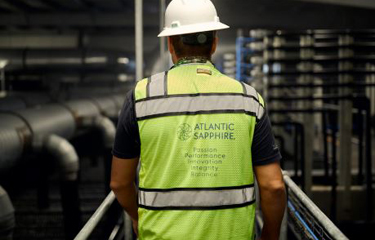Atlantic Sapphire stock price plunges after release of financial report

Shares in recirculating aquaculture system Atlantic salmon farming firm Atlantic Sapphire plunged nearly 20 percent in value on Thursday, 15 April, following the release of its 2020 annual financial report and an update for the first quarter of 2021.
The Sande, Denmark-based company reported a net loss of just over USD 55.2 million (EUR 46 million) in 2020, and it declared Q1 2021 a “lost quarter” for biomass gain at its Miami, Florida, U.S.A. RAS facility. Its net loss represented a USD 42 million (EUR 35.1 million) hike from its USD 13.2 million (EUR 11 million) loss in 2019, though it said the losses were largely due to a ramp-up in operations and personnel, and was partially offset by the commencement of its first harvest in at its Bluehouse RAS facility in Miami, Florida, U.S.A.
However, Atlantic Sapphire also struggled with higher costs due to underutilization of its farming capacity as it deal with several biological problems at its Miami facility. Underuse of its capacity cost the company USD 9.5 million (EUR 7.9 million) in 2020, it said, and it also spent USD 18.2 million (EUR 15.2 million) on material costs, also partially attributed to the biomass problems it struggled through, which also occurred at its Danish farm, where it reported gill damage and "fish movement issues." Its earnings before interest, tax, depreciation, and amortization (EBITDA) was in the red, at a loss of USD 39.9 million (EUR 33.3 million), with revenue of USD 6.3 million (EUR 5.3 million).
Despite the losses, Atlantic Sapphire CEO Johan Andraessen said the company is proceeding with the second phase of construction of its Bluehouse RAS facility this year, which will give the company approximately 25,000 metric tons (MT) of Atlantic salmon production by 2023. But Billund Aquaculture will no longer be involved with the project after Atlantic Sapphire deemed it responsible for problems that led to a mass mortality at its Miami farm in March, as well as other biological issues. Andraessen said Atlantic Sapphire will do its own design and innovation for all future additions to its Miami farm, and that it had hired water treatment specialist Wharton-Smith as general contractor and engineering firm Hazen & Sawyer to oversee design.
“The approach for phase two will significantly reduce risk of design flaws, poor workmanship, delays, and cost overruns,” Atlantic Sapphire said in its April update.
In a slide labeled “Q1 Challenges All Being Addressed,” the company said old poor drum sump and center drain design caused the March die-off, as water quality deteriorated, causing initial mortalities, and then clogging occurred that restricted the flow of new water into the tanks.
“Although work had commenced to rectify the issue prior to this incident, the affected system had not yet been modified,” the company said.
The loss of 500 MT of head-on gutted fish, with an average weight of one kilogram each, was the equivalent of 5 percent of Atlantic Sapphire’s annualized production volume, which the company estimated would cost it USD 3.5 million (EUR 2.9 million) over what it will recoup from insurance.
Following the incident, Atlantic Sapphire made changes to its executive management and organization for the U.S. operation of the company, including the replacement of COO Dharma Rajeswaran with interim COO Bjørn-Vegard Løvik.
Besides fixing its drum filter area and center drains, Atlantic Sapphire is also pursuing a further splitting of its six growout systems into a dozen separate systems, with five of the six having been successfully converted. It’s also working on replacing its internal chiller plant to minimize costly temperature changes, and it recently completed work on its filleting facility.
“On the operational side, 2020 was a year that required heavy lifting on the construction side as we were working hard to complete construction of our Phase 1 Bluehouse facility in the USA and simultaneously farming fish. The pressure was worsened by the COVID-19 pandemic negatively impacting construction and farming activities,” Andraessen said in a press release. “On the positive side, we reached USA’s first harvest in Q3 2020 as initially targeted. We also experienced other great achievements with the development of strong retail partnerships, the introduction of autonomous feeding, and other artificial intelligence capabilities in our operations, the successful listing on the Oslo Børs, and the successful equity raise that gave Atlantic Sapphire the financial muscle to accelerate its growth despite the headwind from the COVID-19 pandemic.”
In its Q1 update, Atlantic Sapphire said it had harvested 421 MT of salmon from its Miami farm and 300 MT from its facility in Denmark. Its net revenue for its U.S. fish averaged USD 6.80 (EUR 5.68) per kilogram and USD 5.96 (EUR 4.97) for its Danish fish, though it received USD 12.00 (EUR 10.02) for its larger, three-kilo salmon grown at its U.S. farm
Atlantic Sapphire remains committed to achieving a total annual production capacity of approximately 220,000 MT HOG by 2031, Andraessen reaffirmed. He further noted an upping of the firm’s DNB-sourced credit facility in January 2021 from USD 150 million to USD 200 million, along with a syndication of its existing credit facility to Farm Credit of Florida as a “green” senior secured debt facility.
Atlantic Sapphire suffered an additional setback on Tuesday, 13 March, when three contracted workers at its Bluehouse facility were hospitalized after being overcome by fumes. The U.S. Occupational Safety and Health Administration and the Miami-Dade Police Department are investigating the incident, CBS Miami reported.
Andraessen issued an update on the condition of the workers via Twitter on 14 April.
“After the incident onsite yesterday, I’m relieved to report that two sub-contractors have been released [from the hospital]. We wish full recovery to the last one! They were cleaning a tank when one had issues after removing his mask. No falls or chemicals involved,” he wrote.
Photo courtesy of Atlantic Sapphire






Share